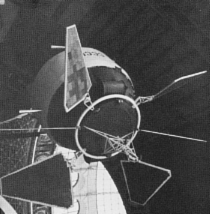|
|
Proton 1 & Proton 2

Proton 1 was launched 16 July 1965 by the USSR into an
orbit with apogee 589 km, perigee 183 km, and inclination 63.4 degrees. The
orbital period was 92.25 minutes. The satellite weighed 12,200 kg. It was
cylindrical in shape with convex ends. The experimental payload included
instruments for monitoring cosmic rays with energies up to 1 X 1014
eV, determining the intensity and energy spectrum of galactic electrons, and
measuring the intensity and energy spectrum of cosmic gamma-rays over 50 MeV.
The satellite reentered the Earth's atmosphere on 11 October 1965.
Proton 2, physically identical to Proton 1, was launched on 2 November 1965.
Its orbital parameters were: apogee 637 km, perigee 191 km, inclination 63.5
degrees. The orbital period was 92.6 minutes. It carried the same payload as
Proton 1, again with the primary interest being ultra-high energy cosmic
particles. It decayed on 6 February 1966.
[Publications]
[All Missions]
[by Time]
[by Energy]
Page authors: Lorella Angelini Jesse Allen
HEASARC Home |
Observatories |
Archive |
Calibration |
Software |
Tools |
Students/Teachers/Public
Last modified: Thursday, 26-Jun-2003 13:48:18 EDT
|


